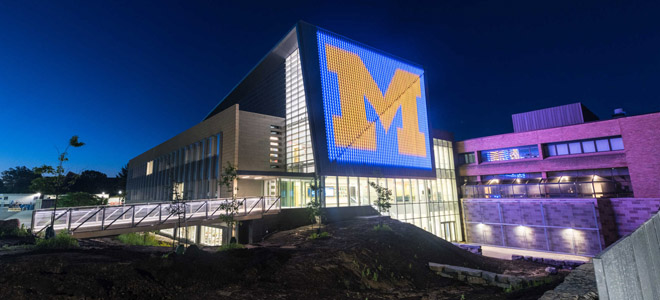BY NICOLE CASAL MOORE
MICHIGAN ENGINEERING
ORIGINAL STORY

In custom ultra-low vibration chambers, University of Michigan researchers can conduct nanoscale experiments so precise that mere footsteps could disturb them if they were performed in a different space.
Inside them, researchers will study how heat moves across atoms in nanoscale devices, and how a single molecule of DNA responds to the slightest of forces, which could give insights into genetic diseases. Those are just a few examples.
“With the emergence of nanotechnology and nanoengineering of the last two decades, a relatively small number of institutions and agencies have been able to construct facilities for ultra-sensitive measurements, and I know of none that are focused on the mission of a mechanical engineering department,” said Edgar Meyhofer, professor of mechanical engineering and biomedical engineering. Meyhofer is leading the DNA work and will collaborate on the atomic heat transfer research as well.
The chambers are part of the $46 million new mechanical engineering research facility, and expansion of the G.G. Brown Laboratories on North Campus that opened one year ago. The 62,880-square-foot addition holds a host of other specialized spaces, including tissue culture rooms and a so-called breaker space. The facility allows researchers to study the forces at work at the smallest scales, to advance nanotechnologies in energy, manufacturing, healthcare and biotechnology.
“This addition enhances the impactful research, multidisciplinary collaboration, and cutting-edge teaching that are hallmarks of our Department of Mechanical Engineering. It is a great example of how we can work with our strong federal, state, community and industry partners to advance education that will produce new products and spur growth in our economy,” U-M President Mark Schlissel said when the center opened its doors in October 2014.
The projects mechanical engineers work on are changing, said Noel Perkins, the Donald T. Greenwood Collegiate Professor and associate chair for facilities and planning in the Department of Mechanical Engineering.
“For a long time, they were on the order of the size of our hands, but it’s no longer limited to that,” Perkins said. “Emerging technologies demand research at the nano- and microscales, and to do that, you need new infrastructure.”
The ultra-low vibration chambers are cornerstones of this new infrastructure at U-M. They keep research still in what Perkins described as “a building-within-a-building.”
The chambers are supported by their own 8-foot-thick concrete slab foundation called a seismic mass, which is separate from the main building’s foundation. The seismic mass is designed to withstand vibration from outside, such as traffic, and inside, such as heating and cooling systems. The chambers are tightly controlled not only to limit shaking, but also noise, temperature and humidity variations, as well as radio frequency and magnetic interference. Lab tables connect directly to the seismic mass through a floating floor so footsteps can’t shake them.
Another of the new building’s amenities is the Microbioengineering Lab. Normally reserved for biology labs, it holds tissue culture rooms where engineering researchers are able to grow the living cells they need to study how proteins might go haywire and lead to cancers, for example, or to test real-time blood infection sensors.
Katsuo Kurabayashi, professor of mechanical engineering and electrical and computer engineering, cultures immune cell lines there. He’s making biochip sensors for quickly finding proteins in blood that could reveal conditions like sepsis, infection and immune deficiencies.
“This lab uniquely provides researchers with a means to develop new technologies and study fundamental biomechanics phenomena by combining micro and nano engineering with biology,” Kurabayashi said.
And in what Professor Ellen Aruda calls the “breaker space,” researchers watch the degradation of materials that go into things like cars, airplanes and medical devices.
“Advancing our understanding of how things break is critical to preventing catastrophic failure in transportation, medical and commodity devices,” said Arruda, a professor of mechanical engineering, biomedical engineering and macromolecular science and engineering.
Those are just a few examples of the vast and varied work it enables.
“Such a facility is indeed unique for mechanical engineering worldwide,” said Kon-Well Wang, the Tim Manganello/BorgWarner Department Chair and Stephen P. Timoshenko Collegiate Professor of Mechanical Engineering. “Our department is a top program that continues to lead, define and shape the future of mechanical engineering. This unique research complex will enhance our ability to do so by enabling transformative research for society in areas such as energy, transportation, manufacturing, healthcare and biotechnology.”
The addition was made possible in part by a $9.5 million grant from the National Institute of Standards and Technology.
“This facility will enable groundbreaking experiments by our faculty and students, resulting in landmark advances at the interface of mechanical engineering and nanoscience. We look forward to watching this progress unfold,” David Munson, the Robert J. Vlasic Dean of Engineering, said at its opening in October 2014.